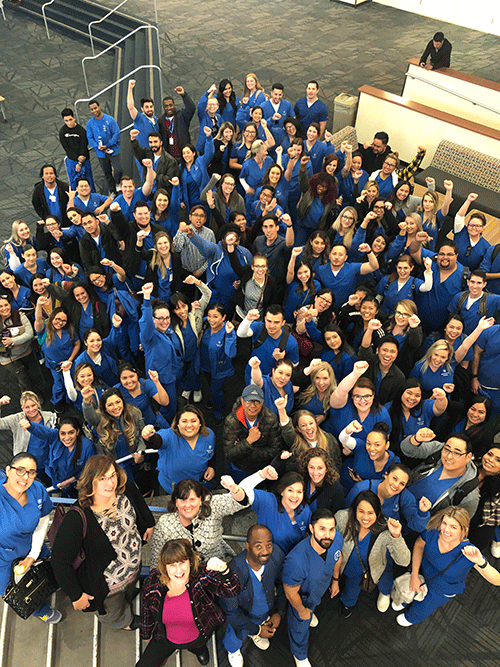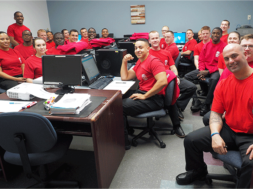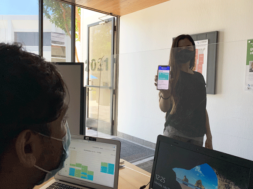
Four Elements Needed for a Successful Teach-Out
Written by Sara Klein from an interview with Mitchell Fuerst, President, Success Education Colleges
Teach-outs are a way for students attending a closing college to continue their educational journeys. When a teach-out occurs, another institution creates a plan to provide continuing services to these students, so they can complete their programs with minimal disruption.
Mitchell Fuerst, a second-generation college administrator, following his mother, Marsha Fuerst, who founded the colleges in 1966, is currently President of Success Education Colleges (SEC), which has 10 campuses in two states, and has 15 years of teach-out experience.
Many years ago, Mitchell went into his mother’s office and told her there was a troubled college, asking her what could be done. “It looks like they may cease their operation; what can we do?” Mitchell said. “His mother then said, ‘Let’s just help the students.’ She was just interested in completing those students’ education. She didn’t ask about financial aid or anything on the monetary side of it; she just wanted to help the students.”
That was his first experience with a teach-out, and he’s been involved with administering eight teach-outs for institutions across California.
There are many reasons why colleges might close and the most important thing to do is to take care of the students.
“College closures happen for a myriad of different reasons. It’s not just issues with accreditation or with the U.S. Department of Education or a financial problem; it’s usually a number of different reasons,” Mitchell explained. “We see this happening across the higher education landscape, which includes public, not-for-profit and private, for-profit institutions.”
Teach-outs don’t only help the students affected; they can be a positive boost for the institution implementing the teach-out.
“Since we’ve done these teach-outs, [regulators in the triad] know our organization even better; they know our team,” Mitchell said. “As a result, I think we’ve gotten an increase in credibility from all regulators because we had the fortitude and ability to finish up the students and bring these teach-outs to a successful conclusion.”
One of the first steps for a teach-out, once there is a college that’s going to cease operations, is for the school that’s closing to reach out to teach-out partners early in the process. However, Mitchell has found that typically the colleges wait too long, trying to remedy their own operation.
“Colleges that are having troubles need to reach out to teach-out partners early in the process, so the college doesn’t precipitously close and then the students are left kind of floating. [The ideal scenario is] where a teach-out agreement is in place and it becomes more of an orderly transition,” Fuerst described.
If a school seeks a teach-out partner early in the process or later, as often happens, the second step is the same, and that is to assemble a team to visit the campuses that are affected. Teams can be comprised of whomever is deemed necessary, but Mitchell uses a specific proven formula that has been utilized many, many times.
“Typically our most senior executive committee members divide up and then usually take other corporate directors, and in many cases campus directors,” Mitchell said.
The next step is for the team to spring into action. Mitchell used the example of Brightwood College, which closed unexpectedly, to further explain what the teams do.
“We sent teams into each one of the [Brightwood College] campuses that were in our areas to talk with students and those team members at those campuses about how we were able to assist,” Mitchell said.
“The team goes to the campus to start talking to the students immediately and talking to team members that their potential is a path forward.”
The team’s main goal is to provide options to the students affected by their closing schools. One option these students have, in California, is they can apply for the Student Tuition Recovery Fund (STRF) to get their loans forgiven, which is perhaps a less than ideal solution for many.
“We have found that in almost all cases the students want to continue their education. They want to complete what they started. Perhaps they could get their money back and their loans discharged and that type of thing, but they can’t get the time back,” Mitchell said. “In the Brightwood situation there were Nursing students who were in an RN program, which is a two-year program and some of them were within four or five months of graduating. So they don’t want to have their loans forgiven, they want to complete their education.”
Another option is for the students to go to another school like a public institution Mitchell explains and how that is also not usually the best solution.
“For example in Nursing, [if they try to go to another school like a public institution], they unfortunately won’t articulate their credits and there are no slots for them anyway to gain admission to a public institution because they’re all impacted,” Mitchell said.
For many, then, the students’ best option is to elect to go to a teach-out if one is provided, as a means to complete their education.

“So [in the Brightwood College] case, we were able to gather the students up and say, you guys have multiple options and we’re going to try to glue together a teach-out where we’re going to hire all the faculty, we’re going to get a facility – either this one or someplace else – and we’re going to continue your education,” Mitchell said.
Teach-outs don’t happen immediately; they take time to put together. One thing that needs to be present is regulatory support. The institution needs to talk to the Department of Education, as well as going through the approval process from the regulatory bodies, which can take anywhere from 3-4 weeks if there aren’t boards or programmatic accreditors, which cause the process to take longer. This particular one took SEC a little less than two months to implement.
“The reason why it took us that long is beside the regulatory triad that gets involved, we had two different Nursing boards to talk to as well,” Mitchell clarified. He further explained that usually teach-outs come together more quickly than two months, because the regulatory triad has been very supportive of teach-outs. “They bend over backwards to do whatever they can to make sure the students can continue their education. I’m talking about national accreditors, our state bureau or oversight agency, and the U.S. Department of Education. In every case they have been very supportive in getting the students back in school.”
After regulatory support, three additional things need to be present for a teach-out: students, employees, and a facility. Students are, arguably, the most important aspect. They need to be communicated with very quickly.
“If you don’t gather [the students] together and tell them that there’s a path forward in continuing their education with their same instructors and potentially in their same facility, they end up dispersing and usually apply for loan forgiveness or tuition relief, which in most cases takes them sometimes years to resolve,” Mitchell said. “Once the students disperse, it becomes very difficult to get them back to class. So you need to communicate with them very early, share the potential plan with them, which is to hire the faculty and staff they’re familiar with and who they trust.”
Financially, it’s always best to protect the students, so they do not end up paying more than they originally planned. Students are already upset about their college closing, so charging more to move forward is like adding salt to the wound.
“In our experience, one way to have the students stay glued in to the process is that we always say we’re going to charge the students no more than they originally signed for on their original enrollment agreement, even if that program that they signed up for is less tuition than ours,” Mitchell explained. “The bottom line is we always prorate it based on the original tuition because they don’t need that additional debt or aggravation. We’ve always found that it’s the best way to do right by the students.”
Sometimes the institution providing the teach-out won’t receive funds at all for certain students if Title IV has already been applied and dispersed.
However, the reason for doing the teach-outs is to simply help them finish their education.
“[Money] is never the focus of our teach-outs and why we have done this so many times over many years. Given our experience, we know that teach-outs are not going to financially burden us. There is a lot of coordination and a lot of work that will stretch our team, [but we never focus on financial aid],” Mitchell explained. “The team in our colleges don’t mind working extra hard because they know that their work is resulting in saving additional students. They feel an enormous sense of pride [in being able to finish up these students].”
One additional thing that the teach-out institution needs to do with the students is communicating with them that they must get their transcripts and ledger immediately.
“These are the two most vital things that we need down the road to enroll them, to put them into our system, and to prorate their tuition. [Their ledger card and their transcript] are the building blocks of a student who’s entering a teach-out institution. If we have to, we advocate for them in talking to their closing school to please get those transcripts and ledger cards printed, so that these students can continue,” Mitchell said.
The third thing needed for a teach-out, after regulatory support and students, is employees. Many times the teach-out institution tries to use the faculty from the closing school, if possible.
“The right recipe for a successful teach-out is to hire the faculty from the closing institution who the student’s trust, because the students feel safe, they feel comfortable, and they feel that there truly is a path forward and there’s somebody there that’s kind of looking out for them,” Mitchell said. Furthermore, it provides a sense of security for the faculty as well. “Again, it’s a huge sense of pride for every one of our existing team members to be able to help not only the students, but the employees from a closed school now have their own path forward of getting a paycheck. Because they’re such terrific employees, we have a spot for them, either long-term or at one of our other campuses. It’s a huge pickup for us. We’ve gotten some of the most fantastic new team members from a teach-out,” Mitchell explained.
The final component needed for a successful teach-out, after the regulatory support, the students, and the faculty, is the facility. Whatever works best is what is used, which could be at the closed college itself, at the teach-out institution if there is room, or another location. Each teach-out will be different, depending on the size and scope of the teach-out. If it’s small, the teach-out institution’s facility may be able to absorb them, but the most successful scenario is when the closing school facility is able to be used.
“We call this another ingredient in our recipe for a successful teach-out and that is to teach them in their existing facility,” Mitchell said. “So we are able to tell them you’re going to have your same instructor, your same curriculum, and you’re going to come right back to this classroom. The only thing that’s going to be different is your scrubs are going to have our institution’s name on it and your enrollment agreement will be with our institution and your diploma will be from our institution.”
All but one of the eight teach-outs Mitchell has been a part of have been able to use the existing facility by negotiating a short-term lease with the landlord.
There are usually equipment needs for the facility as well, and most closing schools “say yes, use the equipment. So we get everything needed. It’s crucial that you have to do that,” Mitchell said. “It’s not like I have equipment and chairs and tables and labs for 300 additional students for a Nursing program within days. Sure, we can assemble that equipment but it’s going to take too much time.”
Financially, in Mitchell’s experience, conducting teach-outs doesn’t financially burden the institution. They may operate in the red slightly, break even, or maybe operate slightly in the black.
“But it’s whatever is in the best interest of the student. As my mom always would say, if we just take care of the student, everything else will be okay. So that’s what drives us to this day,” Mitchell said.
Mitchell believes there needs to be a lot of work done in the area of policies or legislation to help facilitate teach-outs and hopes to be able to get all the stakeholders to come to the table for these kinds of discussions. Many times, the mechanics of a teach-out are really unknown.
“Teach-outs ultimately will save everybody. They save the students, they save the faculty, they save the taxpayers, they save everybody that’s potentially affected. So everybody wins if a teach-out happens,” Mitchell said.
Mitchell also wants to assist school owners and presidents who really want to help, but just don’t understand the recipe for a successful teach-out.
“When [school owners] hear about these kinds of situations, just have them call me. I will walk them through the entire process. I will tell them what to tell the students. I will tell them how to deal with their faculty. I will tell them how to make critical decisions. I’ll literally coach them through the entire thing,” Mitchell said.
There were many reasons Mitchell has continued the tradition of teach-outs, but the number one priority is ALWAYS to help the students.
“We don’t want students to be left in the abyss,” Mitchell said.
School owners or Presidents considering a teach-out but have additional questions, can contact Mitchell Fuerst, President of Success Education Colleges (SEC), at MitchellF@success.edu.
MITCHELL FUERST , a second-generation college administrator, is currently the President of Success Education Colleges (SEC), which is the parent organization he created to hold the Colleges’ three brands (North-West College, Glendale Career College and Nevada Career Institute); a system of allied health schools based in the Los Angeles and Las Vegas areas. Currently, SEC has 10 campuses in two states. His Mother, Marsha Fuerst, founded the Colleges in 1966.
Mr. Fuerst received his Bachelor of Science in Business Administration from California Polytechnic University, Pomona and has a varied background in business and over the past 25 years has been instrumental in the growth and development of the Colleges’ educational programs, as well as Student and Team Member populations. He became the Colleges’ President in the fall of 2010.
Contact Information: Mitchell Fuerst // President // Success Education Colleges (SEC) // MitchellF@success.edu // https://www.success.edu











